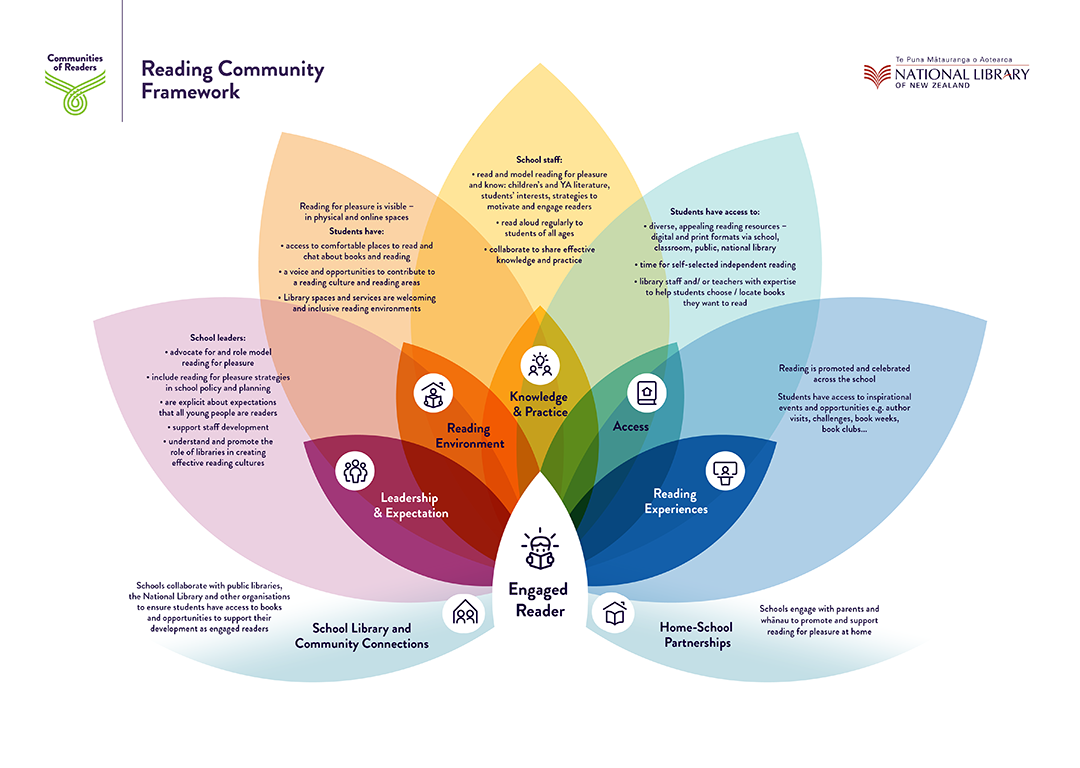

Pūtoi Rito Communities of Readers Phase 1: 2019 – 2021 Summary and Insights Report
Findings from the Phase 1 Pūtoi Rito Communities of Readers Summary and Insights report reinforce proven good practice and detail conditions in Aotearoa New Zealand that inspire and encourage young people to read for pleasure and wellbeing.
March 2022
Introduction
Pūtoi Rito Communities of Readers is a National Library of New Zealand Te Puna Mātauranga o Aotearoa initiative that aims to engage children and young people with reading for pleasure and wellbeing.
“A love of reading can be more important for a child’s educational success than their family’s socio-economic background.”
— OECD, 2002
Voluntary engagement with reading – reading for pleasure, relaxation and enjoyment – has proven lifelong benefits that are demonstrated by national and international research. The benefits include improving literacy, knowledge, academic attainment and cultural understanding. Reading for pleasure provides a foundation for developing a wide range of important literacy skills including digital and critical literacies crucial for participation in today’s complex information and media landscape. Reading also supports identity, personal and social development, empathy and wellbeing.
“An analysis of Growing Up in New Zealand data found that when the cumulative weight of stress is high in the first 1000 days, reading to children is one of the few protective factors.”
— Alex Woodley, First 1000 Days, 2017

Background and context
In Aotearoa New Zealand young people’s levels of literacy and reading for pleasure are in steady decline. There is a lack of equity in access to library services, reading resources, language and literacy-rich environments from early years, and reading role models. There is also a need to develop a shared understanding, across the broader community, of the value and potential impact of engagement with reading on literacy, wellbeing and life outcomes.
“Among 15-year-olds, literacy achievement levels have been dropping and wide disparities remain unchanged. Changes are required to produce equity and excellence outcomes for all students.”
— Stuart McNaughton, The Literacy Landscape in Aotearoa New Zealand, 2020
Reading — growing a nation of readers — is one of three themes in the National Library’s Turning Knowledge into Value, Strategic Directions to 2030. Priorities within the Reading theme include promoting reading for pleasure to improve literacy and wellbeing; contributing to the revitalisation of te reo Māori; and supporting the development of digital and other literacy skills.
National Library Services to Schools has a long-established role in providing services andresources to support reading, literacy and learning across the curriculum, and school librarydevelopment.We are building on this foundation with priorities to improve the reach andimpact of these services; to extend and develop targeted initiatives in areas of high need; and to work collaboratively to strengthen the system of library, literacy and reading services for young people in Aotearoa New Zealand.
Pūtoi Rito Communities of Readers
The National Library developed the Pūtoi Rito initiative in response to the continuing decline in literacy and reading engagement. We recognised that a collective approach was required to begin to address the inequities, through strengthened cross-sector and community connections; and understanding and ownership at a local level.
Another driver was the critical need to grow our national research base in order to improve understanding of the value and potential impact of reading engagement in Aotearoa New Zealand. While there is an extensive body of international research and evidence on the value of reading for pleasure for literacy and wellbeing there is less research that is based within New Zealand settings and context.
Working in collaboration with local and national partners, the National Library delivered four Pūtoi Rito Phase 1 projects during 2019-2021. These focused on tamariki and rangatahi with ages ranging from early childhood through to late teens, and they were delivered in different school and community settings across Aotearoa New Zealand.
Pūtoi Rito Phase 1 set out to influence and strengthen the conditions that lead to the development of a culture of reading, exploring two hypotheses in the Aotearoa New Zealand context:
If we better support young people, educators and their communities to understand, develop and strengthen their reading cultures then they will increasingly read for pleasure, and this in turn will impact positively on their wellbeing and reading engagement.
If we work together with partners, and take an interdisciplinary approach to the complex problem of creating reading cultures, we will improve outcomes for children and young people.
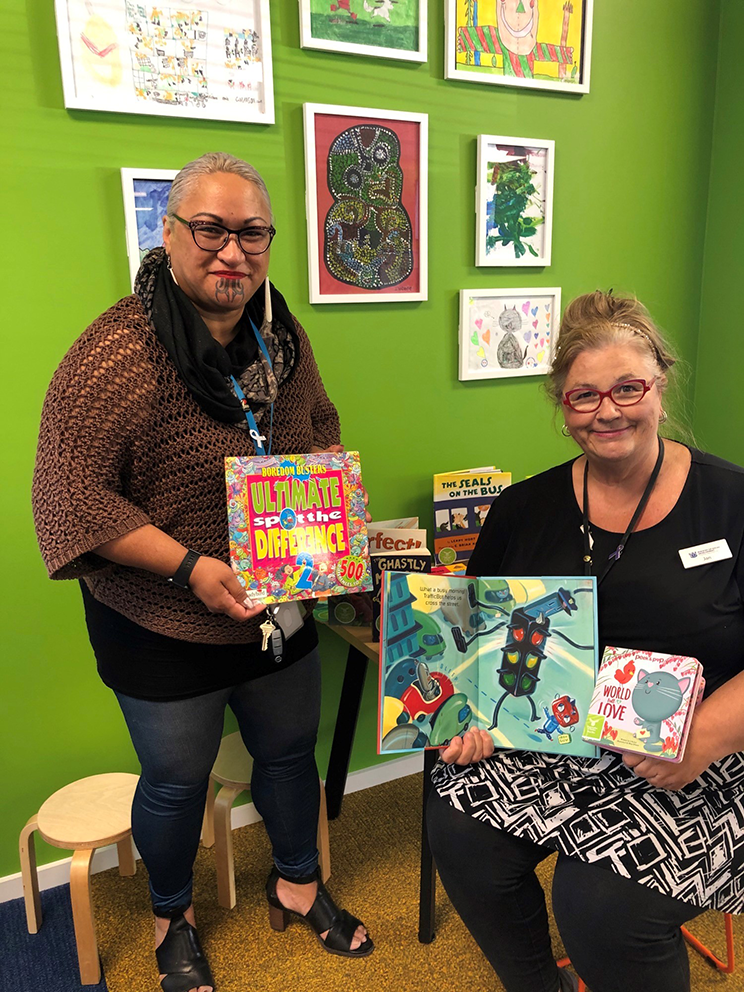
Louise Waho and Jan Swarbrick with books from the Canterbury project at the shared Oranga Tamariki and Work and Income office in Rangiora.
Resources, videos and tools generated during Phase 1 are available online, as well as the research delivered by external professional researchers. The research reports explore the four school and community projects; provide a national and international literature review and summary; and include a supplementary research study on ‘teachers as readers’ in New Zealand schools.
Resources, videos and tools available online
The insights from across the research findings, partner and stakeholder feedback, and internal review are being shared in this report with interested organisations, schools and other communities.
Phase 1 provides initial insights that are informing the further development of this work in the next phase of Pūtoi Rito. As part of the broader National Reading Initiatives 2021-2023, Pūtoi Rito Phase 2 will connect to initiatives across the education, library and community sectors and respond to emerging collaborative opportunities and literacy priorities.
“It’s not just about books, it’s about people, actual people pushing the kaupapa. It’s all good and well to read a poster and grab a book, but it’s the people that are going to make it connect.”
— Family/Whānau, Community Project
Impact of Phase 1
The insights detailed in this report reinforce proven good practice and research findings from across the world, as well as focusing on the conditions that are effective in Aotearoa New Zealand.
They illustrate the leadership and shared purpose required in a local context to bring schools or communities together to create an environment where reading for pleasure is supported, celebrated, prioritised and encouraged.
Pūtoi Rito Phase 1 demonstrates that reading is both an individual pursuit and a social activity that can be stimulated, influenced, inspired and actively enabled by others.
Though there are many factors that can affect reading engagement, the more the community surrounding tamariki and rangatahi understand their own influence in creating young readers and the value and potential impact of reading for pleasure, the more effective they are in encouraging and supporting reading.
“Wouldn’t it be wonderful to see all the adults in their lives support this ambition, with their school, homes, aunts, caregivers, whānau – all the adults in their lives — supporting a love of reading and providing access to books.”
—Partner, Community Project
Two Phase 1 Pūtoi Rito projects were in school settings, with a secondary college in Huntly and with five primary schools in a Kāhui Ako in West Auckland; and two projects were in community settings, with tamariki and their whānau in South Dunedin and with tamariki and rangatahi in care, or on the edge of care, in the Canterbury region. This report includes direct quotes from many participants in the school and community projects.
Though the Phase 1 projects were undertaken at a time when Aotearoa New Zealand was impacted by the COVID-19 pandemic, each project responded flexibly by adjusting activities and schedules and responding to the conditions and needs of the communities.
Pūtoi Rito Phase 1 was funded by Te Puna Foundation, an independent charity established to support the work of the National Library.
“What the Community of Readers has done for us has built a real support and partnership with the National Library and it’s kind of raised our level of expectation I suppose or excitement around reading.”
— Principal, School Project
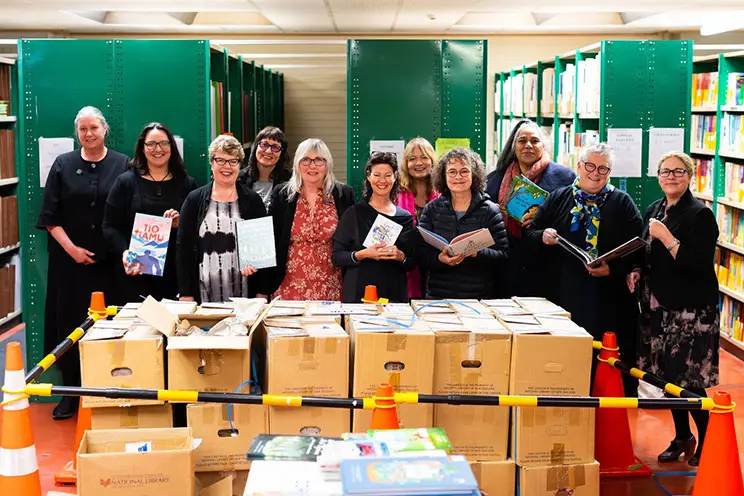
Some members of the South Dunedin Communities of Readers partners and working groups with books for distribution. L to R: Kate Irvine, Amie Curtis, Maxine Ramsay, Lynne Vare, Su Ikin, Kirsty Glengarry, Alex Woodley, Kate De Goldi, Pip Laufiso, Bridget Schaumann and Elizabeth Jones. Photo by Jodie Gibson.
Insights from Pūtoi Rito Phase 1
Pūtoi Rito Phase 1 aimed to develop repeatable, re-usable and transferrable learnings about creating reading communities in an Aotearoa New Zealand context and to build the national research knowledge base.
The insights brought together in this report are from
across the four Phase 1 projects and include:
the research findings from the Pūtoi Rito project research reports, a national and international literature review report and summary and supplementary research on teachers as readers
additional feedback and reflections from partners, collaborators, and National Library staff.
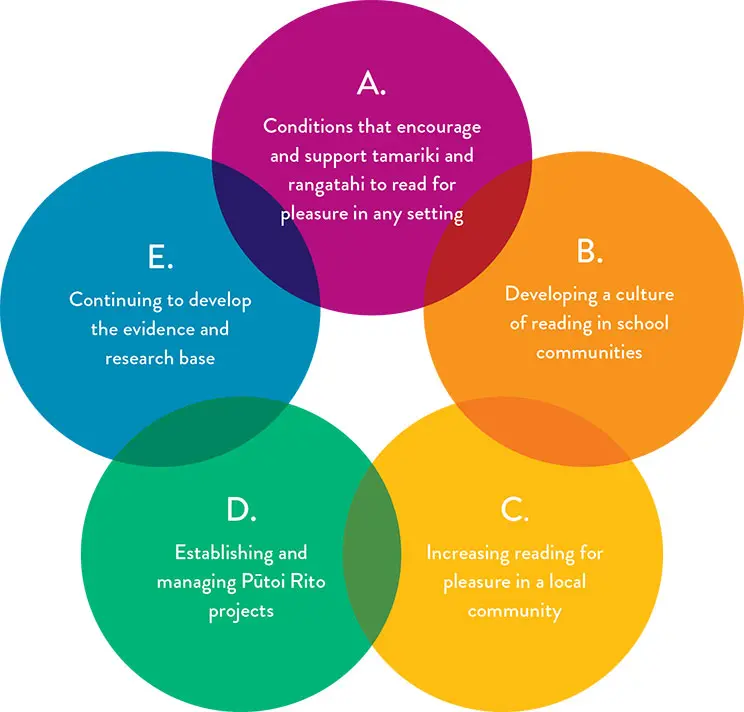
Long description — Insights from Pūtoi Rito phase 1
Diagram outlining the five categories of Pūtoi Rito Phase 1 learnings about creating reading communities in an Aotearoa New Zealand context and to build the national research knowledge base. The five catergories are:
A: Conditions that encourage and support tamariki and rangatahi to read for pleasure in any setting.
B. Developing a culture of reading in school communities.
C. Increasing reading for pleasure in a local community.
D. Establishing and managing Pūtoi Rito projects.
E. Continuing to develop the evidence and research base.
A. Conditions that encourage and support tamariki and rangatahi to read for pleasure in any setting
i. Reading is both an individual pursuit and an activity that can be stimulated, influenced and inspired by others. Whānau, peers, teachers, librarians and community have huge influence as role models and facilitators, through talking about books they have read, telling stories, sharing their own interest and joy in reading, reading with their whānau of all ages, providing access to books, and being seen reading themselves.
ii. The more the community surrounding tamariki and rangatahi understand their influence in creating young readers and the value and potential impact of reading for pleasure, the more effective they are in encouraging and supporting reading.
iii. The deepest engagement with stories and reading often occurs with books in home languages and ‘heart’ languages; there is high demand for books that connect to place, culture and identity, particularly books in Te Reo Māori or with a Te Ao Māori context, and in the diverse languages of Aotearoa.
“Parents, grandparents, aunties, uncles, tamariki and cousins were all in there and they all chose pukapuka that connected with them… They were all so happy with the te reo Māori books available so I thank you all from the bottom of my heart!”
— Partner, Community Project
“It is hard to get books in Arabic. There are very few shops in Dunedin which sell them and there are not many in the library. We were really surprised there were not only books in Arabic, but there was a choice of books.”
— Family/whānau
“It is great to see stories such as Harry Potter translated into Māori, but it would be even better to have books of our stories and our people, and there seem
to be very few of these published.”
— Family/whānau
iv. Tamariki and rangatahi need choice in what they read and the freedom and support to pursue their own interests. They need opportunities to grow their understanding of others as well as themselves; they need ‘windows and mirrors’ that reflect their own identity and open doors to other worlds and possibilities.
“I used to love dinosaurs. I got the book on dinosaurs. My friend got the book on sharks. She doesn’t even like sharks.”
— Tamariki, Community Project
v. Books should be plentiful, high quality, visible in many places, and easily accessible; the combination of high appeal, good quality, variety and accessibility-without-barriers leads to the books being valued and appreciated.
“Students are keen to take the books home to read. The availability
of a range of books has been a significant factor in leading to this shift.”
— Partner, School Project
vi. Expert selection, consultation, curation and reading suggestions based on a wide knowledge of the literature for tamariki and rangatahi, are highly valued and appreciated.
“Sharing extensive and insightful knowledge about children’s books was gold. We don’t have anyone on the staff with this knowledge. Maybe one person comes close? but I don’t think so. What a wonderful resource!”
— Teacher, School Project PD session

Allia and Zena King at the
Teddy Bear’s Hospital in South Dunedin. Dunedin City Council.
B. Developing a culture of reading in school communities
i. Books alone are not enough in a school. To build a culture of reading, educators and others in the school community need to understand the profound and long-term value of reading for pleasure, and have the professional knowledge and practice to successfully encourage reading.
“The findings of this study suggest that some teachers may not always feel, or be, supported in devoting class time to reading, listening to, thinking, and talking about text purely for pleasure. This finding suggests a lack of knowledge either of what it takes to create readers or of the correlation between reading for pleasure and academic (as well as social and emotional) outcomes in the longer term.”
— Research Report, Teachers as Readers
ii. Within the school community, it should be explicit that all students are expected to be readers. All students can be encouraged and inspired to engage with reading.
iii. Principals and other school leaders are powerful reading champions, as reading role models themselves, as well as ensuring reading engagement is a visible commitment and priority in the school.
“You can’t leave reading to chance in a school. So I think whatever opportunity there is, you pick it up. But as a leader, you’ve got to lead it.”
— Principal, School Project
iv. Teachers who are readers and who see themselves as readers, understand the benefits of reading for pleasure and want their students to be readers. The small research study undertaken by NZCER for Pūtoi Rito found that teachers who see themselves as readers use a range of strategies to realise their aspirations for their students; they model a ‘reader’ orientation to text and meaning-making, support reading for pleasure across the school, and consider their approaches to be successful in increasing engagement and achievement in reading.
“... The gold standard—at least according to the teachers in this study—is teachers who are themselves passionate readers and bring their reader identities to school with them.”
— Research Report, Teachers as Readers
v. A focus on creating a culture of reading in a school can lead to teachers rediscovering and reigniting their own love of reading.
“It has made teachers more aware of what is available to them, refired their own reading for pleasure and talking about books with their classes.”
— Teacher, School Project
vi. Students and teachers love ‘book talking’ and ‘book chat’ – discussing books and hearing why others are interested in a particular book. Getting a glimpse into what someone else likes about a story, or finds of interest in it, can break an invisible barrier for many people. Reading aloud also makes stories accessible to young people, helping to engage them with reading.
“I once believed that reading aloud a chapter of a book may have yielded
low engagement. But what I have found is that students, although at first may say they dislike the idea of reading, actually love stories and want to hear them.”
— Teacher, School Project
vii. Schools should actively encourage and enable students to read during the long summer holidays, to counter the established ‘summer slide’ effect. This is an opportunity to strengthen the connections between school libraries and public libraries through joint summer reading initiatives, and access to reading resources can be supported by increased National Library loans and by loosening of school library borrowing policies.
viii. Home-school partnerships and connections between schools, public libraries, community groups and whānau are vital for strengthening and reinforcing the development of lifelong reading.
ix. The school library and library staff play an important role in literacy development and in helping to create a school culture that supports and encourages reading for pleasure. School libraries also provide a space that is welcoming and safe; a space to select and share books, to read and to talk about books.
“The library also has become quite a large space for people to hang out, it’s quite common to come in here at lunchtime and it’s loud and buzzing and people are on the computers or reading books or talking and it’s become quite a happy environment to be around.”
— Student, School Project
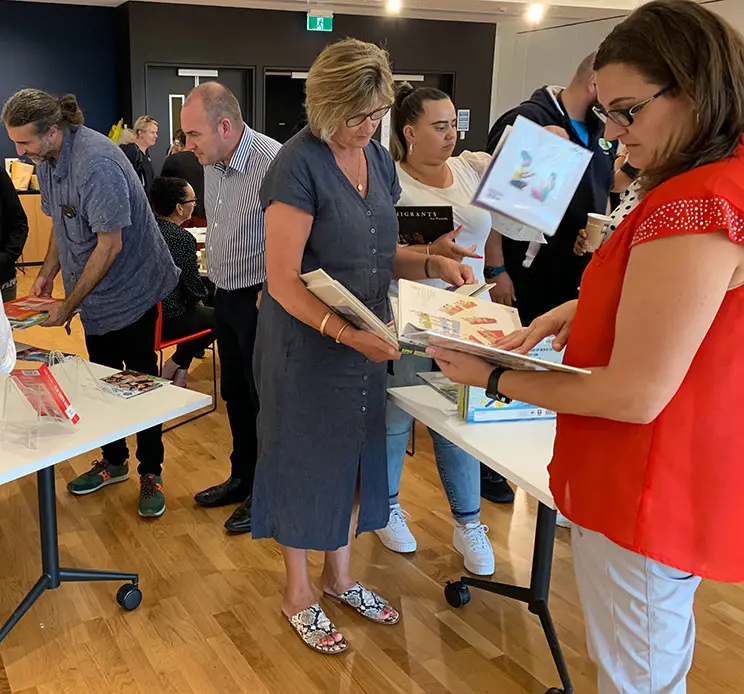
Staff from Kāhui Ako o Tiriwā browsing books at a Professional Development event held at Te Manawa library in West Auckland.
C. Increasing reading for pleasure in a local community
i. Projects should be generous and joyful, creating good associations with reading; encouraging a strengths-based approach, without a ‘deficit’ context, or blame, guilt or shame.
“It (the Read Share Grow campaign) represents all that is good about South Dunedin.”
— Partner, Community Project
ii. Consider Te Ao Māori context from the beginning and throughout the projects, as an effective partner to Te Tiriti o Waitangi.
“One of the most important relationships that we have within the working group and of course the partnership is one with mana whenua. This means that we’ve also got a really strong engagement I think.”
— Partner, Community Project
iii. Include youth voices in the partnerships through all the stages of the projects.
“Do involve young people from the very start. “Nothing about us without us” should be the mantra for any work ‘for’ youth. This involvement should be meaningful and genuinely located in ‘mana ōrite’.”
— Partner, School Project
iv. The projects are strengthened by adapting to, building on and leveraging existing connections and relationships in the community; each project was supported by champions who emerged during the projects and became pivotal to their success; ripples of interest and enthusiasm were generated in the projects that engaged many new community advocates and supporters.
“Couldn’t have happened without the collaborative approach. Needed the input from those who know the wider community, the schools and services, the library network and the city-wide support in order to bring it all together. Has drawn upon the diversity of the community and the willingness of people to engage as a community. Pacific, Māori, former refugees have melded as part of the process. The combination of the strengths is where the evolution would lie.”
— Partner, Community Project
v. The local partnership approach to encouraging reading engagement can impact established systems and contribute to the removal of barriers.
“Basically, they didn’t use the library because they were afraid they would end up paying some money at some point or another. So that gave us renewed enthusiasm to press for a fine-free approach to people under 18 years of age. So, we’ve now successfully implemented a ‘fine-free for youth’ regime within our library service and we will be communicating that more widely as time goes on.”
— Partner, Community Project
D. Establishing and managing Pūtoi Rito projects
i. Building the local and national partnerships in each project takes time. The initiation phase (often six months or more) is essential for developing the trust needed for effective partnerships but can also impact the time available for project delivery. Collective impact community projects often have a time frame across many years.
“The partnership approach not only enabled project and community capability but, given the iterative and generative nature of the project, also allowed us to exceed the project and community capability.”
— Partner, School Project
“I believe that we didn’t go far enough, we needed to continue the project for longer to enable us to get into the community as a whole.”
— Librarian, School Project
ii. Co-design and collaboration – developing and delivering the project with local partners in response to local factors – are necessary for effective engagement, collective ownership and sustainability.
“The co-design project gave us real community voice particularly around perceptions about reading, about literature, about school, about education – that it was really important for us to take heed of.”
— Partner, Community Project
iii. Partners need a strong shared understanding of the value and impact of reading for pleasure, as well as willingness and capability to collaborate, and adaptability and flexibility as projects evolve and change.
iv. A key enabling factor was the backbone support, leadership, strategic approach, expertise and resourcing provided by the National Library, within a context of shared ownership, responsibility and identity.
“This feels like one of those rare programmes where the link between the desired outcome (more books in high-needs homes/communities) and the method (give them free books) is a blessedly straight line.”
— Partner, Community Project
v. Leadership is critical; leaders of the partner organisations must be involved and committed advocates for the projects – in school and local community contexts – ensuring the projects are visibly supported as priorities.
“I particularly valued the involvement of senior organisational representatives (National Librarian, Ministry of Education Regional Director) in the project as recognition of the priority and importance of the project. These are also a reason in my view for its success.”
— Partner, Community Project
E. Continuing to develop the data, evidence and the national research base
i. Changes in attitudes, confidence and behaviour were recognised across the Pūtoi Rito Phase 1 projects and are captured in the project research reports and in the insights from partners and stakeholders.
“ … the early evidence suggests that many of the books are going to families with few or no children’s books at home. There is also emerging evidence that the right books, in the right places, at the right time, in home and heart languages is having an impact on shared reading. All the families who had received books said they had read them to their children and that both they and their children were enjoying them, particularly if the children had been able to choose the book themselves.”
— Research Report, Community Project
“ Reading and storytelling has spread throughout many facets of the school, through reading relationships, texts shared, online engagement and community activities. These outcomes suggest a culture of reading is seeded by people who have interest, commitment, knowledge, resources, authority, and a willingness to collaborate.”
— Research Report, School Project
ii. Alongside current research initiatives, robust longitudinal research specifically focused on the value and impact of reading for pleasure would be of critical benefit; many factors contribute to the data and evidence measures that are currently used as literacy and well-being indicators.
“Further research is needed, in the context of Aotearoa New Zealand, into the experiences of their students as readers. Such research might focus on the extent to which students take up the knowledge, beliefs, attitudes, and values towards text and meaning-making held and modelled by their teachers.”
— Research Report, Teachers as Readers
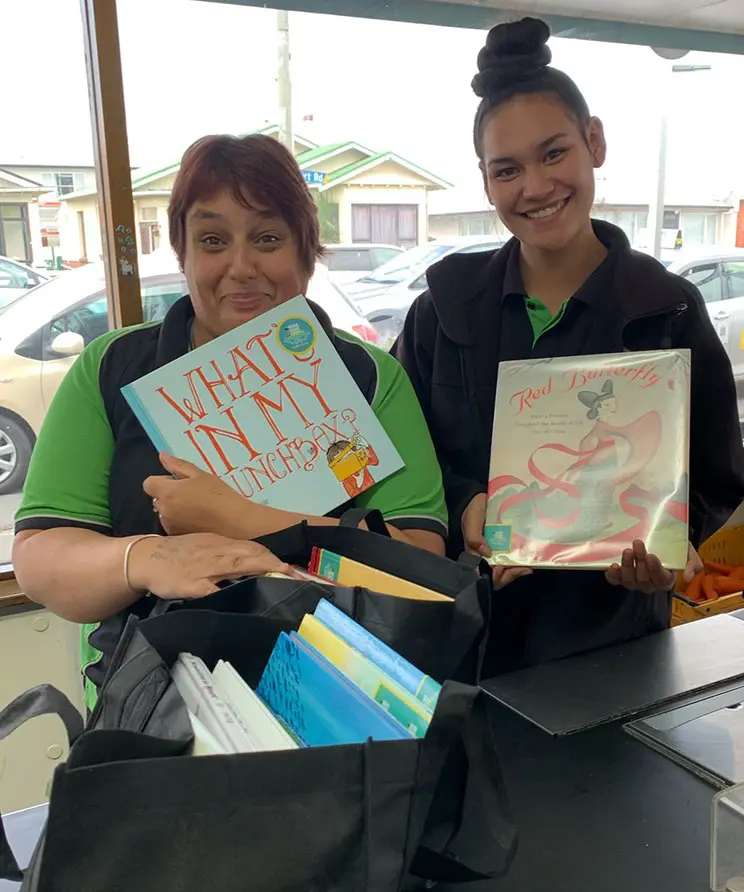
Veronica and Faythe from Veggie Boys — one of the many businesses and organisations distributing books in South Dunedin.
About the Pūtoi Rito initiative
The first phase of Pūtoi Rito Communities of Readers commenced in mid-2019 following a Government grant to Te Puna Foundation to fund the initiative. Pūtoi Rito Phase 1, led and delivered by the National Library of New Zealand, included four community partnership projects focusing on engaging tamariki and rangatahi with reading for pleasure.
Reading for pleasure can include fiction and non-fiction, short form
and long form, and in print or digital formats. Some forms and formats are more suited to some types of reading and interests. For example, printed books are often more able to hook and engage tamariki and rangatahi with stories and are more easily read aloud, swapped and shared. There are also particular benefits from engaged, sustained and absorbing reading, which generally occurs in long-form reading.
Initiating the Phase 1 projects
Pūtoi Rito Phase 1 commenced in late May 2019 and closed on 30 September 2021. Phase 1 was delivered through a period impacted by the COVID 19 pandemic. Each project responded flexibly by adjusting activities and schedules, and responding to the conditions and needs of the communities. Phase 1 tested two hypotheses:
If we better support young people, educators and their communities to understand, develop and strengthen their reading cultures then they will increasingly read for pleasure, and this in turn will impact positively on their wellbeing and reading engagement.
If we work together with partners and take an interdisciplinary approach to the complex problem of creating reading cultures, we will improve outcomes for children and young people.
Three projects commenced between August 2019 and March 2020. These were in Dunedin (August 2019), West Auckland (December 2019), and Huntly (January 2020). The fourth project in Canterbury commenced in November 2020, following the disruption of the first COVID lockdown period from March – June 2020.
The criteria for selection and initiation of the four Communities of Readers projects included:
Existing leadership and readiness
Identified need and challenges
Diversity and range of project environments, locations, scale and contexts
Working with a range of age groups from early childhood through to late teens
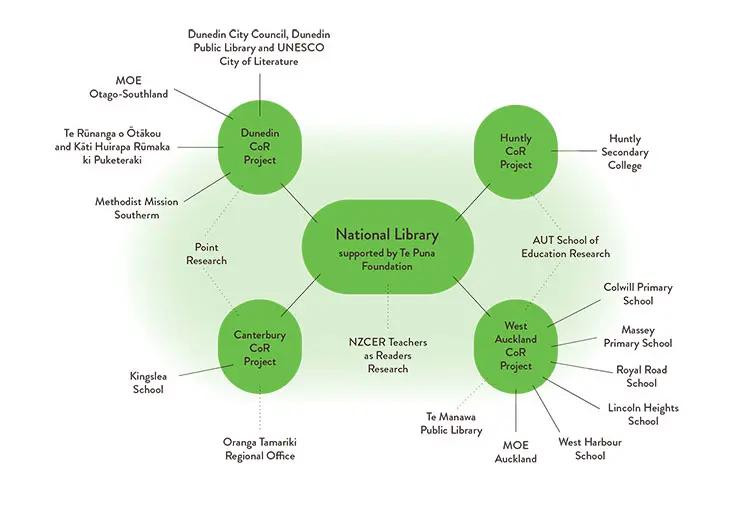
Long description — Pūtoi Rito partnerships
A diagram made up of 5 circles with lines and names radiating out of the the cirlces. This shows the Pūtoi Rito Phase 1 Communities of Readers partners, collaborators and researchers
National Library supported by Te Puna Foundation worked with the following on the different projects.
South Dunedin project
Partners working with National Library in the South Dunedin project include:
Dunedin City Council, including the Dunedin Public Library and UNESCO Dunedin City of Literature
Ministry of Education Otago/Southland Regional Directorate
Te Rūnanga o Ōtākou and Kāti Huirapa Rūnaka ki Puketeraki
Methodist Mission Southern
Research — Point and Associates
West Auckland Te Kāhui Ako o Tiriwā project
The partners in this project included:
Massey Primary
Royal Road School
West Harbour School
Colwill School
Lincoln Heights School
Ministry of Education Auckland Regional Directorate, and
National Library of New Zealand.
Research — The Auckland University of Technology School of Education
Huntly College project
Huntly College and the National Library worked together to support staff and student leaders to promote and inspire students to read for pleasure and wellbeing.
Research — The Auckland University of Technology School of Education
Canterbury Communities of Readers project
The partners are National Library and Kingslea School with a hub for the project at the Arahina ki Ōtautahi School in Richmond. The partners are working with government and community support agencies in the region including Oranga Tamariki.
Research — Point and Associates
Additional research
NZCER Teachers as readers in New Zealand primary and intermediate schools.
Programme benefits
The Benefits Intervention Logic for Phase 1 (see below) identified three proposed benefits, noting an approximately equal weighting of each benefit, and connections between the three:
Local stakeholders, such as schools, libraries, ECEs and community services, work together to develop reading cultures that support young people reading (Joined-up approach)
Children and young people in the community projects have the opportunities and support they need to develop a love of reading (Sustainable outcomes)
Repeatable, re-usable and transferrable learnings and research about creating flourishing reading communities in New Zealand (Transferrable learnings)
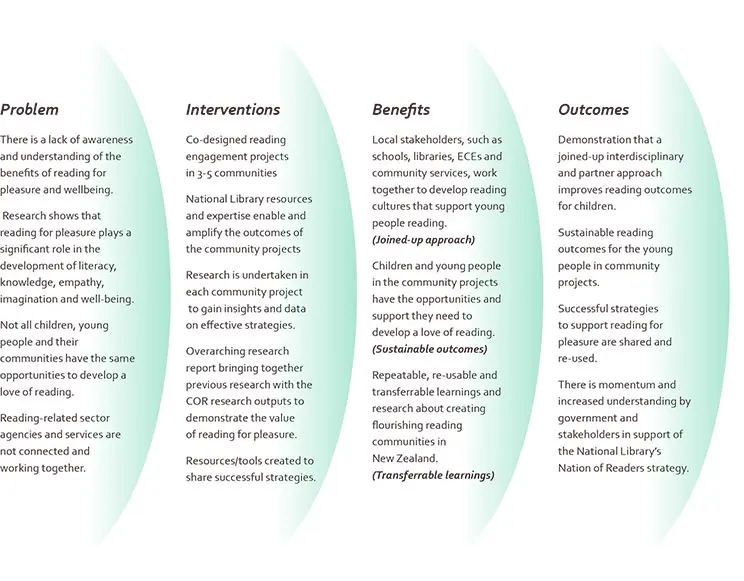
Long description — Pūtoi Rito intervention logic
A diagram with four headings and words underneath.
Problem
There is a lack of awareness and understanding of the benefits of reading for pleasure and wellbeing.
Research shows that reading for pleasure plays a significant role in the development of literacy, knowledge, empathy, imagination and well-being.
Not all children, young people and their communities have the same opportunities to develop a love of reading.
Reading-related sector agencies and services are not connected and working together.
Interventions
Co-designed reading engagement projects in 3-5 communities
National Library resources and expertise enable and amplify the outcomes of the community projects.
Research is undertaken in each community project to gain insights and data on effective strategies.
Overarching research report bringing together previous research with the COR research outputs to demonstrate the value of reading for pleasure.
Resources/tools created to share successful strategies.
Benefits
Local stakeholders, such as schools, libraries, ECEs and community services, work together to develop reading cultures that support young people reading. (Joined-up approach).
Children and young people in the community projects have the opportunities and support they need to develop a love of reading. (Sustainable outcomes)
Repeatable, re-usable and transferrable learnings and research about creating flourishing reading communities in New Zealand. (Transferrable learnings)
Outcomes
Demonstration that a joined-up interdisciplinary and partner approach improves reading outcomes for children.
Sustainable reading outcomes for the young people in community projects.
Successful strategies to support reading for pleasure are shared and re-used.
There is momentum and increased understanding by government and stakeholders in support of the National Library’s Nation of Readers strategy.
The projects demonstrated these benefits in the following ways:
1. Joined-up approach
i. There was positive stakeholder engagement in all four projects; and no partners withdrew from the project or left the collaborations.
ii. In the community projects (Dunedin and Canterbury), Pūtoi Rito fostered new areas of common interest and local collaboration; and in the school projects (West Auckland and Huntly), new connections were made, or connections were strengthened, between the schools, public libraries and the National Library.
iii. In Dunedin, Canterbury and West Auckland, there was active and productive collaboration between the National Library and the Ministry of Education regional directorates and national office. In Canterbury, the National Library worked closely with the regional office of Oranga Tamariki across multiple sites.
iv. Reflections and feedback from the stakeholder survey showed strong support for the collective impact and locally-focused approach – ‘working with’ the local community.
v. The mix of national and local organisations allowed each to contribute different expertise, resourcing and perspectives to the projects; and reinforced the shared understanding of the potential value and impact of reading engagement.
vi. The learnings from Pūtoi Rito Phase 1 that relate to the effective establishment and management of collective impact projects align closely with international experience
2. Sustainability
i. Growing the awareness and understanding of the value of reading for pleasure is critical to sustainability and long-term impact. The value of reading was highlighted throughout the projects with reading engagement strategies being shared extensively with all involved. This included: professional development for school staff, and the development of resources such as frameworks and review tools; informal information sharing; a public awareness campaign; and discussions with community and whānau in many settings and contexts.
ii. Approximately 16,600 books were distributed to tamariki and rangatahi through the community projects, directly benefitting more than 2,000 tamariki and rangatahi. These will continue to be owned and shared by these whānau. Extensive additional loans from the National Library Lending Service were generated in the two school projects, and capability and confidence to use the services was strengthened.
iii. The National Library will maintain strong relationships with the schools involved in the West Auckland and Huntly projects that have closed, and provide ongoing reading engagement support, to leverage the gains and shared understanding developed during the projects.
3. Transferrable learnings
i. The transferrable learnings from Phase I are outlined on pp.9-15.
ii. The learnings and insights from Pūtoi Rito Phase 1 demonstrate that reading
is both an individual pursuit and an activity that can be stimulated, influenced, inspired and actively enabled by others.
iii. Though there are many factors that can affect reading engagement, the more the community surrounding tamariki and rangatahi understand their own influence in creating young readers and the value and potential impact of reading for pleasure, the more effective they are in encouraging and supporting reading.
Four Pūtoi Rito projects 2019-2021
Canterbury Communities of Readers
Commenced November 2020; continuing into Pūtoi Rito Phase 2
Project partner
Kingslea School
Project stakeholder participants
Oranga Tamariki Canterbury Regional Office; Ministry of Education Regional Directorate
Project focus and activities include:
inspiring a love of reading among tamariki and rangatahi in care or on the edge of care, and their caregivers, in the Canterbury region
providing a wide range of books for Oranga Tamariki sites and associated services, including to support the Gateway Assessment Programme at Christchurch Hospital and Greymouth Hospital
providing books for tamariki and rangatahi and their whānau at Kingslea School sites
connecting with caregivers, social workers and care team workers to share information about reading for pleasure
reading engagement information session for all Kingslea school staff.
Age range
tamariki and rangatahi aged 2-18
Research
Canterbury Communities of Readers Report, Point and Associates; Lead researcher, Alex Woodley; May 2021
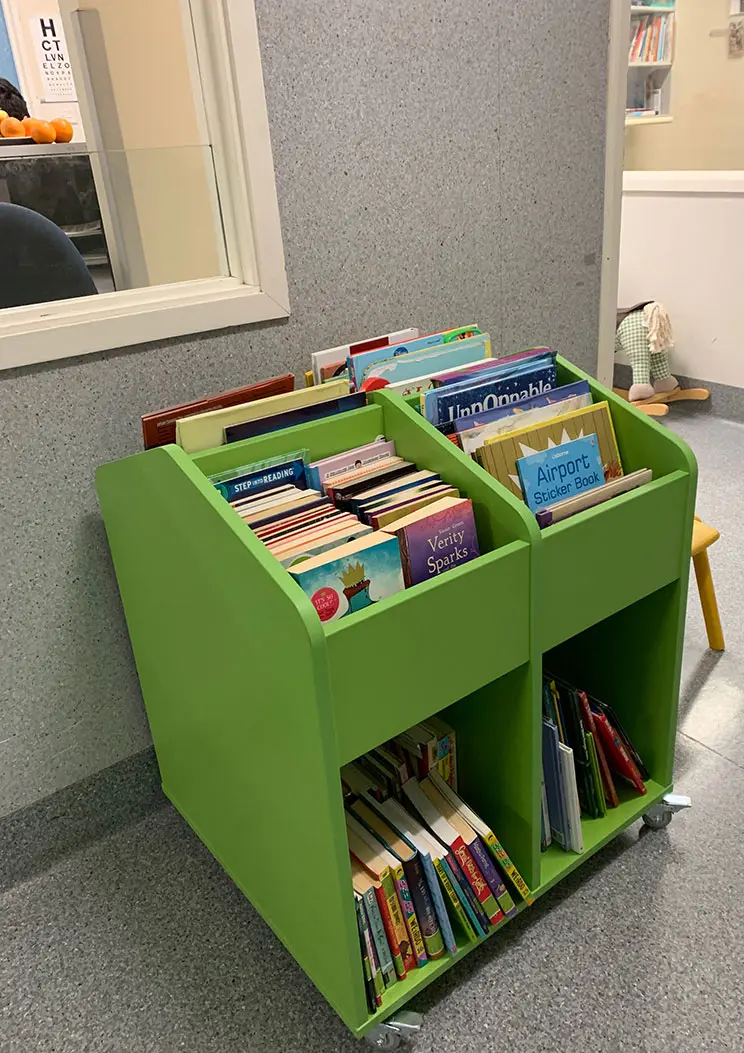
Pūtoi Rito bookstand at the Gateway Assessment Programme at Tiaki Whānau/Child and Family Safety Service at Christchurch hospital.
Dunedin Communities of Readers
Commenced August 2019; continuing into Pūtoi Rito Phase 2
Project partners
Dunedin City Council (including Dunedin Public Library and UNESCO City of Literature); Methodist Mission Southern; Otago/Southland Regional Office Ministry of Education; Te Rūnanga o Ōtākou and Kāti Huirapa Rūnaka ki Puketeraki
Project focus and activities include:
increasing the number of young readers in South Dunedin aged 3-7 inspired to read for pleasure and well-being, through the period of transition from early childhood learning to school
running a targeted public communications campaign about the value of reading for pleasure and wellbeing using local creative talent, graphics and images
providing reading engagement support for schools and ECEs
contributing to local community events and offering programmes and activities for whānau
Age range
tamariki aged 3-7
Research
• Co-design Report, Methodist Mission Southern, Jan 2020
• South Dunedin Communities of Readers Report, Point and Associates; Lead researcher, Alex Woodley; May 2021
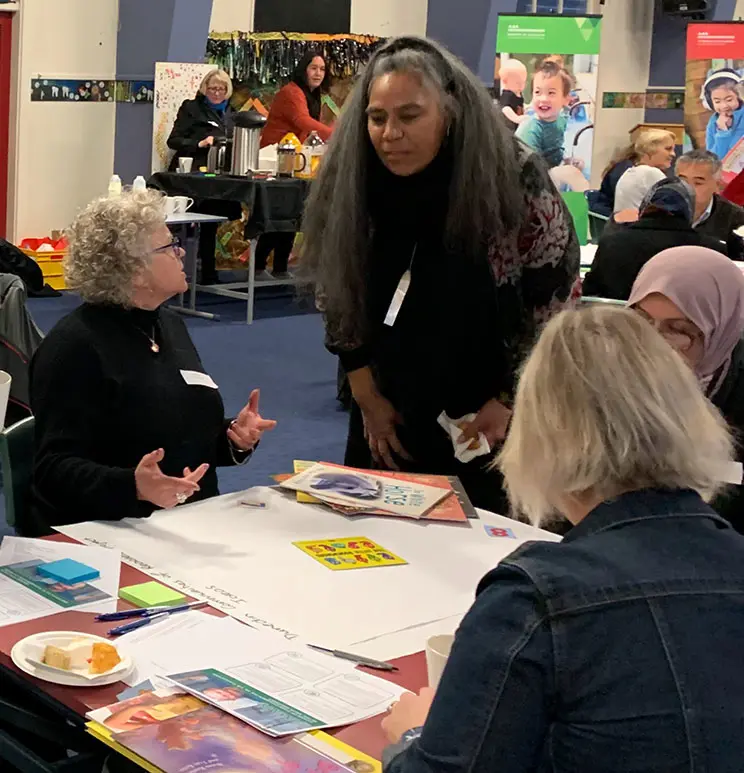
Pip Laufiso, Education Adviser Priority Learners, Ministry of Education leading community hui at Bathgate Park school.
Huntly Communities of Readers
January 2020 – July 2021
Project partner
Huntly Secondary College
Project focus and activities include:
supporting staff and student leaders to promote and inspire the students to read for pleasure and wellbeing
providing professional development for teachers and staff on reading engagement strategies
supporting all teachers and staff to read for pleasure themselves through providing book loans and vouchers
providing a range of reading events and author visits for students that connect with culture and identity, including whole-school visit to the National Library in Auckland and Auckland Museum
supporting opportunities for whānau engagement at the school through the Festival of Stories in July 2021
increasing engagement with the school
library, and strengthening the online presence and access to loan resources through the school librarya small cohort of student research associates worked with the AUT researchers
and contributed to the research process.
Age range
students aged 13-18
Research
A Changing Story of Reading at Huntly College, AUT School of Education; Principal investigator, Dr Ruth Boyask; Co-investigators, Celeste Harrington, John Milne, Daniel Crouch; Sept 2021
Teacher survey, August 2021, Pūtoi Rito Team
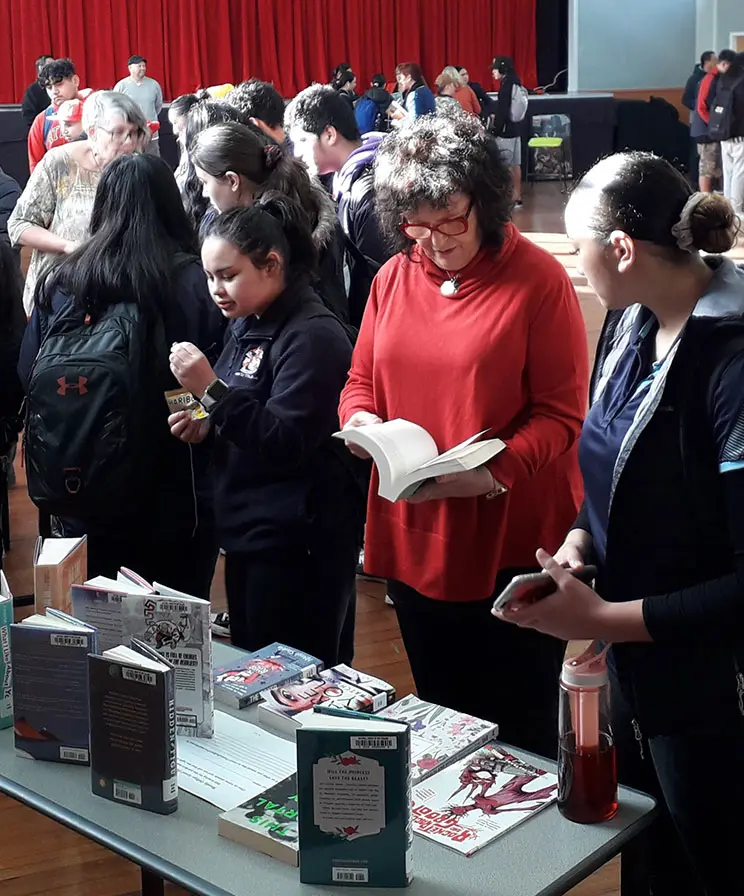
Huntly College staff and students at the Speed Date a Genre Session.
West Auckland Communities of Readers
December 2019 – July 2021
Project partners
Five primary schools in Kāhui Ako o Tiriwā; Auckland Regional Office Ministry of Education
Project focus and activities include
encouraging and enabling teachers to nurture the joy of reading in their school
providing professional development for teachers and staff on developing school reading cultures, reading engagement strategies and resources
supporting teachers to engage in reading for pleasure
strengthening engagement with the school library, building connections with the local public library services and increasing use of National Library services
author visits, support for summer reading programming and reading-related events in the schools.
Age range
students aged 5-13
Research
• Making Reading for Pleasure Visible in Five Primary Schools from Te Kāhui Ako o Tiriwā, AUT School of Education; Principal investigator, Dr Ruth Boyask; Co-investigators, Celeste Harrington, John Milne, Daniel Crouch; Sept 2021
• Teacher survey, July 2021, Pūtoi Rito Team
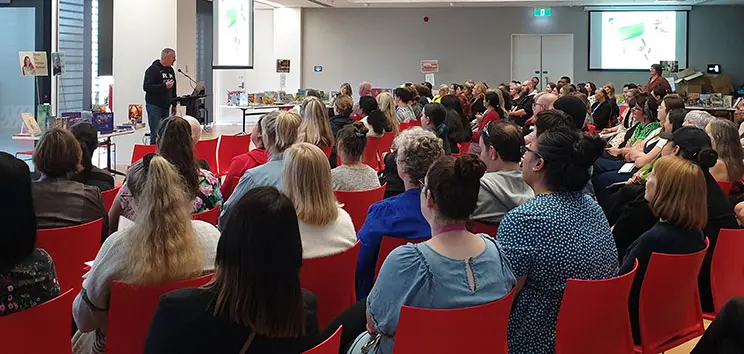
Children’s author David Riley presents to staff from Kāhui Ako o Tiriwā at an event at Te Manawa library in West Auckland.
Research components
Communities of Readers Literature Review Report; and Summary
Reading for Pleasure: for the Collective Good of Aotearoa New Zealand and A national agenda on reading for pleasure: a summary of insights from Communities
of Readers initiative, AUT School of Education; Principal investigator, Dr Ruth Boyask; Co- investigators, Celeste Harrington, John Milne, Daniel Crouch; Sept 2021
National and international literature review focused on reading for pleasure and reading communities in education and other settings; presented in the context of reading in Aotearoa New Zealand and including insights from the Communities of Readers schools- based projects in West Auckland and Huntly.
Teachers as Readers, Supplementary Research
Teachers as Readers, NZCER; Lead researcher, Sue McDowell; Sept 2021.
Focusing on teachers’ identities as readers, and the impact this has on their approaches to reading, text, and talk around text in their schools and classrooms.
Interviews with eight primary and intermediate teachers from schools that varied in terms of decile, type, size, and location (ranging from Dunedin to Te Tai Tokerau) who identify as readers.
Research reports from the four Pūtoi Rito Projects 2019-2021
Canterbury Communities of Readers Project report
South Dunedin Communities of Readers Project report
Huntly Communities of Readers project
West Auckland Te Kāhui Ako o Tiriwā Communities of Readers project
Resources and tools
School culture review tools
Two survey tools for primary and secondary schools, developed and tested as part of West Auckland Communities of Readers and Huntly Communities of Readers, to review current reading for pleasure practice, to identify areas of strength and areas to develop and enhance. Developed by Jo Buchan, Reading Programmes Lead, Communities of Readers and Jeannie Skinner, Facilitator, National Capability, Services to Schools.
Reading frameworks
Two frameworks for use in delivery of PD for teachers and school library staff; and available on the S2S website: Creating a Reading Culture Framework; Teachers as Readers Framework. Developed by Jo Buchan, Reading Programmes Lead, Communities of Readers.
Videos
Two videos (approx. 7 mins each) on: Communities of Readers Phase 1 initiative; Creating a school reading community. Video production by Bazzacam. September 2021.
Campaign and promotional materials
Read Share Grow public communication campaign, South Dunedin (developed by Firebrand); Pūtoi Rito collateral materials and visual identity elements (developed by DNA and Mark Creative)
Web pages
Pūtoi Rito Communities of Readers | National Library
Canterbury Communities of Readers project
West Auckland Te Kāhui Ako o Tiriwā Communities of Readers project
Huntly Communities of Readers project
South Dunedin communities of readers project
Research reports
A school reading community (frameworks) | Services to Schools
A school-wide reading culture (School Reading Culture Review tools) | Services to Schools
Read Share Grow | South Dunedin Communities of Readers
Create Readers blogs | Services to Schools
Read Share Grow — children’s books for South Dunedin
Keeping teenagers reading
Create readers — nurture the skill and will
Media
Pūtoi Rito
The Conversation article by AUT researchers: Kiwi kids who read for pleasure will do well in other ways — it’s everyone’s responsibility to encourage them, 2 Dec 2021 — this article was picked up by multiple other news agencies including RNZ, Yahoo and others.
Dunedin Communities of Readers
Otago Daily Times
Reading fun in any language
‘Korero With Kids’ enjoyed
Book space to encourage reading for pleasure
70s live again in Dunedin Study Exhibition
My Little local Dunedin news — South D Communities of Readers Project, 2 Nov 2020
The Star — Books Drive for young readers, 6 Nov 2020

Long description — Reading community framework
The Reading Community Framework is half a flower shape made up 12 overlaping petals with the engaged reader at the centre.
The inner 7 petals are:
leadership and expectation
reading environment
knowledge and practice
access
reading experiences
home-school partnerships
school library and community connections.
The outer petal from leadership and expectation is headed school leaders who:
advocate for and role-model reading for pleasure
include reading-for-pleasure strategies in school policy and planning
are explicit about expectations that all young people are readers
support staff development
understand and promote the role of libraries in creating effective reading cultures.
The outer petal from reading environment is headed Reading for pleasure is visible — in physical and online spaces. Students have:
access to comfortable places to read and chat about books and reading
a voice and opportunities to contribute to a reading culture and reading areas.
Library spaces and services are welcoming and inclusive reading environments.
The outer petal from kKnowledge and practice is school staff who:
read and model reading for pleasure and know:
children’s and young adult (YA) literature
students’ interests
strategies to motivate and engage readers
read aloud regularly to students of all ages
collaborate to share effective knowledge and practice.
The outer petal from access is students have access to:
diverse, appealing reading resources — digital and print formats via school, classroom, public, National Library
time for self-selected, independent reading
library staff and/or teachers with expertise to help students choose/locate books they want to read.
The outer petal from reading experiences says:
Reading is promoted and celebrated across the school.
Students have access to inspirational events and opportunities, for example, author visits, challenges, book weeks, book clubs.
The petal titled home-school partnerships says schools engage with parents and whānau to promote and support reading for pleasure at home.
The petal titled school library and community connections says schools collaborate with public libraries, the National Library, and other organisations to ensure students have access to books and opportunities to support their development as engaged readers.
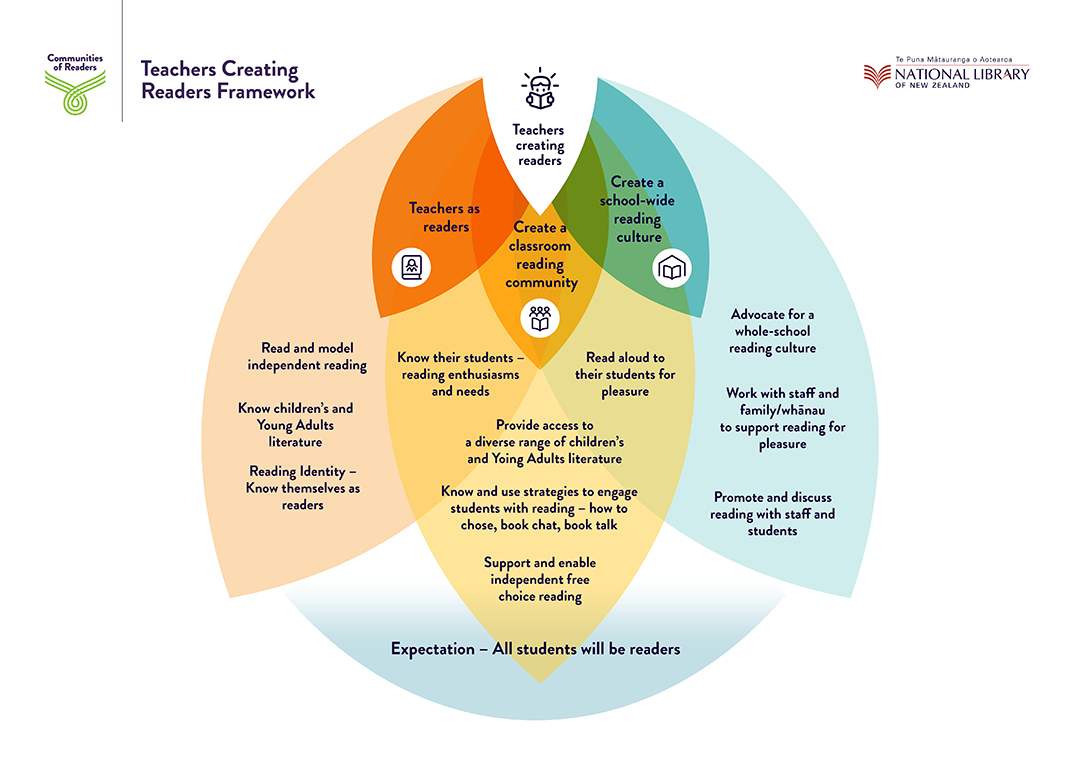
Long description — Teachers creating reading framework
The Teachers Creating Readers Framework is half of a flower shape with six overlaping petals.
Three of the petals show interconnected ways that teachers can create readers:
The expectation of the framework is that all students will be readers.
The teachers as readers petal encourages teachers to:
read and model independent reading
know children’s and young adult (YA) literature
know themselves as readers
The create a classroom reading community petal suggests that teachers:
provide access to a diverse range of children’s and YA literature
know and use strategies to engage students with reading — how to chose, book chat, book talk
support and enable independent free choice reading.
The create a school-wide reading culture petal includes the following suggestions:
advocate for a whole-school reading culture
work with staff and family/whānau to support reading for pleasure
promote and discuss reading with staff and students
Where the create a classroom reading community petal overlaps with the teachers as readers petal teachers will:
know their students' reading enthusiasms and needs.
Where the create a classroom reading community and create a school wide reading culture petals overlap teachers are encouraged to:
read aloud to their students for pleasure.
National Reading Initiatives 2021–2023
During Phase 1, National Library developed two initiatives alongside and in alignment with Pūtoi Rito. These are Te Awhi Rito Reading Ambassador initiative and the cross-sector collaboration called He Pārekereke, national conversations on reading. The initiatives are part of the National Library’s strategic priorities related to literacy and wellbeing for young people, including reading for pleasure, the revitalisation and use of Te Reo Māori and improved digital and other literacy skills.
With the three reading initiatives, National Library has a wide range of partners and stakeholders within a broad and interdisciplinary cross-sector environment. We are taking a broader and more holistic approach, connecting to related education, library and community sector initiatives and responding to emerging collaborative opportunities.
In the next phase during 2021-2023, Pūtoi Rito, Te Awhi Rito and He Pārekereke are managed as an integrated programme as part of the National Library’s Literacy and Learning division, funded by National Library and by grant funding provided by New Zealand Libraries Partnership Programme to Te Puna Foundation.
The research framework for the three National Reading Initiatives over the next two years tests the following hypotheses:
If we have a national advocate and champion for reading for young people (a national reading role model),they will build visibility and awareness of reading across all sectors in Aotearoa New Zealand, and grow other champions in the community, helping tocreate a nation of readers. (Te Awhi Rito Reading Ambassador)
If we work together with local and national partners, build capability in communities, libraries and schools, and take a connected and interdisciplinary approach to the complex problem of creating reading cultures in communities, we will increase reading engagement and improve outcomes for tamariki and rangatahi. (Pūtoi Rito Communities of Readers).
If we raise awareness of the value and impact of reading for pleasure and provide more opportunities for public discourse across sectors and environments, the proven benefits of reading engagement will become more understood – particularly by those who are not currently engaged with reading – and embedded in social, educational and cultural activities across Aotearoa New Zealand. (He Pārekereke National Conversations on Reading)
Pūtoi Rito Phase 2
In Pūtoi Rito Phase 2, the National Library is continuing and extending two of the Phase 1 projects (Dunedin and Canterbury) and developing one to two new partnership projects. Phase 2 will build on and leverage the learnings and insights from Pūtoi Rito Phase 1.
In the new and continuing projects, the National Library will:
partner with communities where there is high need and a willingness and readiness to work with us – one of the projects will include a Kura or Māori Medium setting
work closely with school libraries and/or public libraries, building capability and capacity in the library sector
include research commissioned from external researchers
include the development of tools and resources that can be widely shared.
Research in Phase 2 will expand and deepen the research in Dunedin and Canterbury and further explore theories and evidence of change. The preferred research approach will be developmental early in the project, formative during the projects to help create understanding and identify strengths, and share qualitative and quantitative analysis throughout the project.
National Library will also be looking to support other research projects that further this work.
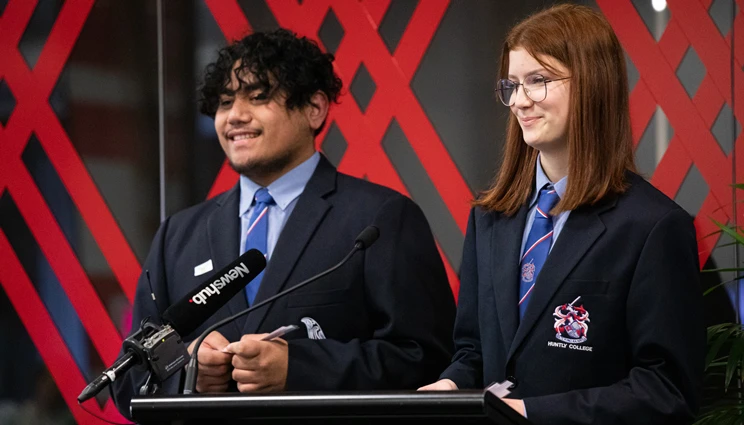
Tien Ngahere and Katie-Rose Janmaat from Huntly College speaking at the launch event of the New Zealand Reading Ambassador at the National Library. Photo by Mark Beatty.
About He Pā Rito naming framework
The names Pūtoi Rito,Te Awhi Rito, He Pārekereke and He Pā Rito come from the harakeke or flax plant. The ‘Rito’ is the young shoot at the centre of the plant and ‘Te Awhi Rito’ are the strong, mature leaves that stand straight and tall to surround, protect and nurture the Rito. Outside Te Awhi Rito are the ‘Tupuna’ or older leaves that bend towards the ground, supporting the inner leaves and eventually become part of the fertile ground beneath. He Pā Rito is the whole harakeke, the interconnected system that is a healthy plant, or group of plants.
The harakeke is sometimes used as a metaphor for generations in a family. Te Awhi Rito are parents, connecting the young people or Rito in the centre of the bush to their grandparents or Tupuna.
For the National Reading Initiatives, He Pā Rito represents the National Library’s strategic direction to grow a nation of readers. This is the system of relationships and supports required from many organisations, authors, teachers, libraries, government agencies and other advocates to strengthen the reading culture in Aotearoa New Zealand and support the Rito — the new and young readers.
Pūtoi Rito is the flax woven together as a community to support the young Rito or reader (Communities of Readers); Te Awhi Rito is the Reading Ambassador, protecting the Rito and championing reading; and He Pārekereke is the seedbed or seedlings that nourish and share diverse ideas about the value and impact of reading.
This framing for the National Reading Initiatives was developed during 2020-2021, led by Ruki Tobin, Poutiaki Rauemi, National Library Services to Schools.

Acknowledgements
Pūtoi Rito Communities of Readers initiative is led by National Library of New Zealand Te Puna Mātauranga o Aotearoa, part of Te Tari Taiwhenua Department of Internal Affairs.
Funding for Phase 1 was provided by Cabinet to the Te Puna Foundation, an independent charity established to support the work of National Library of New Zealand Te Puna Mātauranga o Aotearoa. Engagement with reading is a priority focus for the Foundation and the Trustees are influential supporters of Pūtoi Rito and the other national reading initiatives.
Governance and strategy were led by the Communities of Readers Programme Board: Elizabeth Jones, National Library (Director, Literacy and Learning, and Business Owner); Lewis Brown, National Library (Director, NZ Libraries Partnership Programme, and Project Executive); and Kate De Goldi, Te Puna Foundation (Chair, Te Puna Foundation, and Investment Representative).
Pūtoi Rito Phase 1 programme was managed by Kate Irvine, National Library, with support and expertise contributed by:
Pūtoi Rito Communities of Readers team based in Auckland (Jo Buchan, Reading Programmes Lead; Rosemary Tisdall, Collections Lead; and Melanie Kaipo, Project Coordinator)
National Library Services to Schools specialist staff based in many locations across the country
staff in many other parts of the National Library and Te Tari Taiwhenua Department of Internal Affairs.
Research expertise was provided by: AUT School of Education; Point and Associates; and NZCER.
We would like to particularly thank the partner organisations and our collaborators in each Pūtoi Rito project and acknowledge their commitment, expertise, time and enthusiasm for the work.
Copyright
All images are used with permission March 2022.
Crown Copyright
The material contained in this report is subject to Crown copyright protection unless otherwise indicated. The Crown copyright protected material may be reproduced free of charge in any format or media without requiring specific permission. This is subject to the material being reproduced accurately and not being used in a derogatory manner or in a misleading context. Where the material is being published or issued to others, the source and copyright status should be acknowledged. The permission to reproduce Crown copyright protected material does not extend to any material in this report that is identified as being the copyright of a third party. Authorisation to reproduce such material should be obtained from the copyright holders.
ISBN: 978-0-473-62879-6
Download the Pūtoi Rito Communities of Readers Phase 1: 2019–2021 Summary and Insights Report
Feature image at top of page — Detail of a photo of students from Huntly College browsing books at the Festival of Stories.